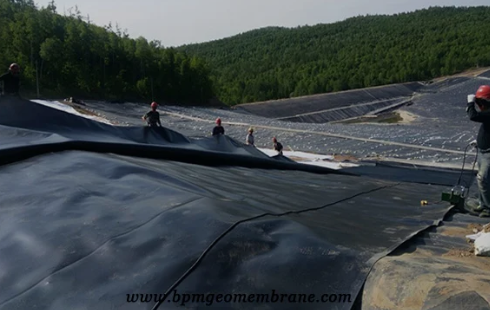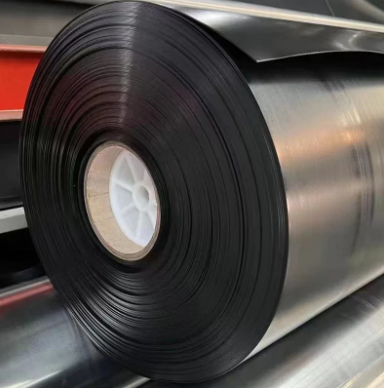- Understanding the Role of Geomembrane Liners in Waste Management
- Innovations in Geomembrane Liners for Water Management
- Geomembrane Liners: A Comprehensive Guide
- The Future of Geomembrane Liners in Civil Engineering
- Geomembrane Liners: Enhancing Landfill Stability
Manager:Alvin Wang
WhatsApp:+62 8983806051
Tel:+86 10-5797-1075
Email:steelwang@okorder.com
Address:3rd Floor, No.2 Building, No.1 Sanlihe Road
What does HDPE geomembrane dissolve in?
High-density polyethylene (HDPE) geomembrane is well-known for its durability, flexibility and resistance to various environmental stresses. However, there are substances that may affect its structural integrity. In this article we will explore the chemical properties of hdpe Geomembranes, discuss their interaction with different substances and answer the question what does HDPE geomembrane dissolve in?

Understanding HDPE Geomembrane
Composition and Characteristics:
HDPE geomembrane is a thermoplastic polymer made up of ethylene monomer units. It has excellent strength, flexibility and chemical resistance which makes it suitable for use as liners in landfills, ponds or reservoir covers among other things. The material creates an impermeable barrier that stops liquids and gases from passing through thus protecting environment as well as ensuring structural stability.
Chemical Structure:
The molecular structure of this type of geomembrane consists long hydrocarbon chains without much branching giving rise to linear molecules that are relatively dense packed together. Such arrangement contributes greatly towards high level of chemical resistance exhibited by them since such compounds do not readily react with majority aqueous solutions including acids, bases and organic solvents among others. Therefore they remain inert under most conditions hence their usefulness where long term exposure to aggressive environments is anticipated.
Interactions with Substances
Resistance to Dissolution:
One outstanding feature about HDPE geomembranes is their ability withstand dissolution by many materials. Being hydrophobic in nature implies these plastics should not dissolve or breakdown when they come into contact with water, acid, alkali bases or any other known organic solvent either. This resistivity ensures that such membranes can last for very many years even if used places like dams where there are frequent changes between wetness and dryness.
Compatibility with Aqueous Solutions:
HDPE liner works well together with majority aqueous solutions commonly found in different industries and environmental settings. It remains intact mechanically even after being soaked under water; be it fresh seawater or brine solution. Such liners also do not disintegrate when placed underwater for storage tanks used during pond lining construction since they resist dissolving into liquid media like sea water or other types of saline solutions.
Chemical Resistance:
Another important aspect is the fact that these materials exhibit good tolerance towards various chemicals such as acids, bases, salts and organic solvents too. They stay unaffected by corrosive substances therefore can be employed areas with high concentration levels such as chemical storage facilities where there could be contact between strong acids/bases etc., industrial waste water treatment plants among others hazardous waste containment zones which may contain aggressive compounds that attack less resistant polymers.
Limitations and Considerations
Temperature Effects:
Although HDPE geomembranes have very high resistance to most chemicals, long term exposure at elevated temperatures might alter some mechanical properties. When subjected to prolonged heating periods above their melting points they tend soften thus becoming prone towards deformation leading loss dimensional stability as well structural integrity should not happen because this material has good thermal stability properties expected from polyolefins like HDPEs. Therefore proper measures needs taken either through designing appropriate cooling systems around them or selecting suitable materials having better capabilities withstand higher service temperatures than those specified for given application involving thermoplastics like (HDPE) geomembrane liners...
UV Degradation:
Over time sunlight through UV radiation can degrade surface layers on HDPE geomembrane resulting oxidation embrittlement decreasing strength properties. Geomembranes are naturally resistant to ultraviolet rays but continuous exposure under direct sunlight could necessitate addition stabilizers or protective coatings enhance longevity outdoor performance.

Conclusion
Ultimately, it can be said that HDPE geomembrane is highly impervious to water, acids, alkalis and organic solvents because of being hydrophobic and chemically inert. This ability coupled with its capability to work well with aqueous solutions while resisting degradation by chemicals makes this material perfect for many uses in containment systems and waterproofing applications. Understanding how these compounds react with each other or other things around them chemically is vital for engineers and managers involved in projects where such materials are utilized over extended periods under different environments as they plan for their reliability.
- Previous:Does HDPE geomembrane dissolve in water?
- Next:What happens when HDPE geomembrane is burned?
-
2024-12-05Geomembrane Liners: A Comprehensive Guide






